Posted by Jane Metters LaBarbara.
September 24th, 2018
Blog post by Jane Metters LaBarbara, Assistant Curator, WVRHC.
Banned Books Week, the last week in September, is an annual event celebrating the freedom to read and to seek and express ideas (even unpopular ones), spotlighting censorship and censored authors. It dates back to 1982, and is supported by a national coalition. The Libraries celebrate this year’s Banned Books Week with a display in the Downtown Campus Library entrance and a historical discussion on banned books presented by Law Library Special Collections Librarian & Archivist Mark Podvia and the ACLU of the WVU College of Law (Wednesday, September 26, 12-1 PM in Room 141).
While the West Virginia & Regional History Center seems like a quiet place to do historical research, our book collection is not without controversy. In this post, I’m going to highlight a few books that have made waves here. Read the rest of this entry »
Posted in West Virginia Collection | No Comments »
Posted by Jane Metters LaBarbara.
September 5th, 2018

Blog post by Stewart Plein, Assistant Curator for WV Books & Printed Resources & Rare Book Librarian
Faces smudged with coal dust, clothing torn and dirty, hands cut and bruised from reaching down to pick slate from chutes beneath them; this was the fate of the young boys who worked in the mines in the late nineteenth and early twentieth century in West Virginia, Pennsylvania, Ohio, and elsewhere in the United States. Read the rest of this entry »
Posted in West Virginia Collection | No Comments »
Posted by Jane Metters LaBarbara.
August 27th, 2018
Blog post by Michael Ridderbusch, Associate Curator, WVRHC.
One of the treasures at the Libraries’ History Center is a collection of original World War I propaganda posters, mostly American, acquired in the 1960s. Their eloquence in communicating a message through text, composition, and coloration is testimony both to the urgency of their purpose, to convince Americans to support the war, and to the more limited channels of communication available at that time, since print media was a primary means of communication. Television and the internet had yet to be invented, and radio was only in its infancy. For example, one of the earliest radio stations, KDKA in Pittsburgh, began broadcasting in 1916. It is in this context that it becomes comprehensible to us today why the method of distributing posters to the American public was a focus of the federal government’s efforts to advance its agenda, one of garnering public support for involvement in an European war. Read the rest of this entry »
Posted in West Virginia Collection | No Comments »
Posted by Jane Metters LaBarbara.
August 6th, 2018

Blog post by Stewart Plein, Assistant Curator for WV Books & Printed Resources & Rare Book Librarian
Although Isaac Asimov, one of the greatest science fiction authors of all time, passed away in 1992, his work lives on in the West Virginia University Rare Book Room. One of the most prolific science fiction authors of the twentieth century, Asimov made a huge impact on how we view the future.
Asimov was responsible for more than 500 authored and edited publications. Among his most popular novels are the Foundation Trilogy, The Martian Way, and The Stars like Dust. Books that were turned into movies include I, Robot, the Fantastic Voyage, and the Bicentennial Man.
Perhaps Asimov’s single most important work is the short story/novella, Nightfall, published in 1941. This story is considered the best science fiction short story written prior to the 1965 establishment of the Nebula Awards, the organization responsible for recognizing the best in science fiction or fantasy published in the United States. The Rare Book Room holds important copies of Nightfall in a variety of formats, including books and records. Its popularity led the story to be adapted for radio, film, podcast, and vinyl. Read the rest of this entry »
Tags: Rare Books
Posted in West Virginia Collection | No Comments »
Posted by Jane Metters LaBarbara.
July 30th, 2018
Blog post by Michael Ridderbusch, Associate Curator, WVRHC.
Elmer Walton (1897-1960) of Martin’s Ferry, Ohio, as a member of the 4th Regiment, 3rd Division of the American Expeditionary Force in France, participated in the Second Battle of the Marne (July 15 to August 6, 1918), and in two campaigns of the final “Hundred Days Offensive” including St. Mihiel (September 12-15, 1918) and the Meuse-Argonne Offensive (September 26 to November 11, 1918).
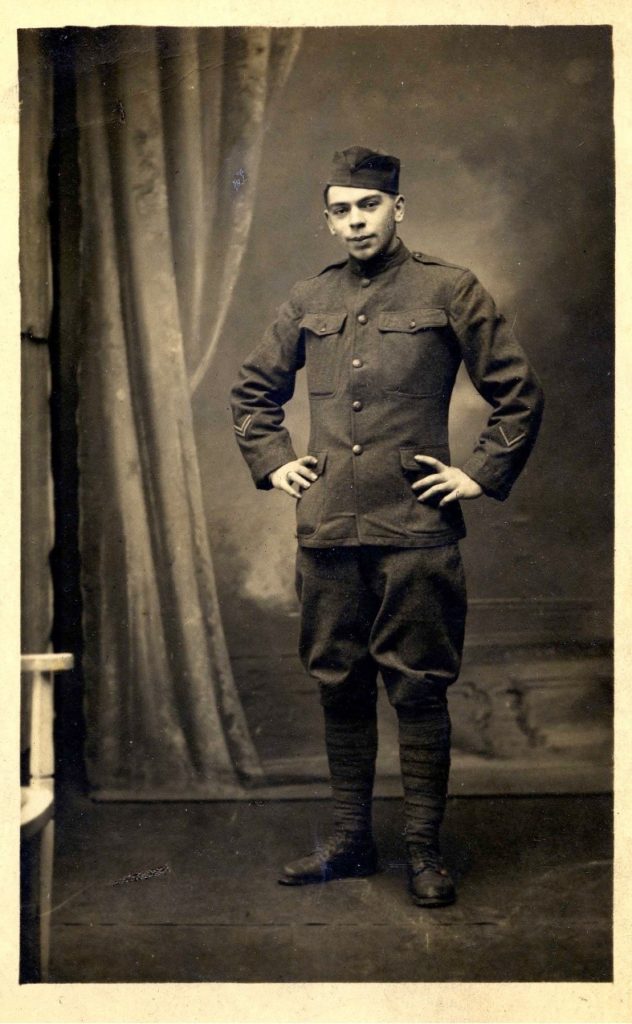
Portrait of Elmer A. Walton, By a Photographer in France, 1918.
(Photo from collection A&M 3694, Elmer Arthur Walton, Soldier,
World War I Letter, Scrapbook, and Other Material) Read the rest of this entry »
Posted in West Virginia Collection | 1 Comment »
Posted by Jane Metters LaBarbara.
July 27th, 2018
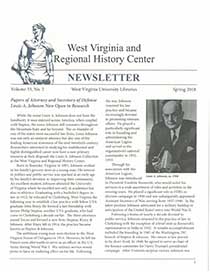
The latest newsletter of the West Virginia & Regional History Center is now available online. The two feature articles are “Papers of Attorney and Secretary of Defense Louis A. Johnson Now Open to Research,” detailing the life and accomplishments of one of the founders of Steptoe and Johnson, and “WVRHC Research Grants Assisting Scholars from Around the Globe,” which includes reports from three recipients of the WVRHC research grants.
You can read a PDF copy of the newsletter online or contact the Center to request a print copy. If you want to see back issues of the newsletter, they are all online and accessible through our Newsletter webpage.
Posted in West Virginia Collection | No Comments »
Posted by Jane Metters LaBarbara.
July 20th, 2018
Blog post by Stewart Plein, Assistant Curator for WV Books & Printed Resources & Rare Book Librarian
It’s been a long time since I spent the afternoon baking. I’ve never been fond of making cookies but I enjoyed making pies. Both activities require the use of a rolling pin. The only pin I had was the traditional household rolling pin, a cylinder of wood slipped onto a metal bar with two handles, one on each end, allowing it to roll as I pressed out the pie dough. Read the rest of this entry »
Posted in West Virginia Collection | 1 Comment »
Posted by Jane Metters LaBarbara.
July 2nd, 2018
Blog post by Jane Metters LaBarbara, Assistant Curator, WVRHC.
I recently accessioned an autograph book. By following some of the clues in the book and using some basic genealogy resources, I found out more about its owner.

Flipping through it, I saw that it included a lot of signatures from 1879 through about 1883, some poems, and some really beautiful hand-drawn art. Read the rest of this entry »
Posted in West Virginia Collection | 2 Comments »
Posted by Jane Metters LaBarbara.
June 28th, 2018
Blog post by Michael Ridderbusch, Associate Curator, WVRHC.
A century has passed since the participation of the United States in the First World War in 1917-1918, and of course West Virginians volunteered, like so many other Americans, after declaration of war on April 6, 1917. A recent acquisition of the History Center, including letters and photographs, details the war odyssey of West Virginian John Thorn of the 462nd Aero Squadron. Read the rest of this entry »
Posted in West Virginia Collection | 3 Comments »
Posted by Jane Metters LaBarbara.
June 14th, 2018
Blog post by Lori Hostuttler, Assistant Director, WVRHC.
Seventy five years ago today, on Flag Day, June 14, 1943, the Supreme Court of the United States (SCOTUS) handed down its decision in the case of West Virginia State Board of Education v. Barnette. This landmark case expanded religious freedom for all Americans under the free speech clause of the First Amendment of the Constitution. The ruling said that mandatory flag salutes in public schools violated free speech and were therefore unconstitutional – reversing a decision from just three years earlier.
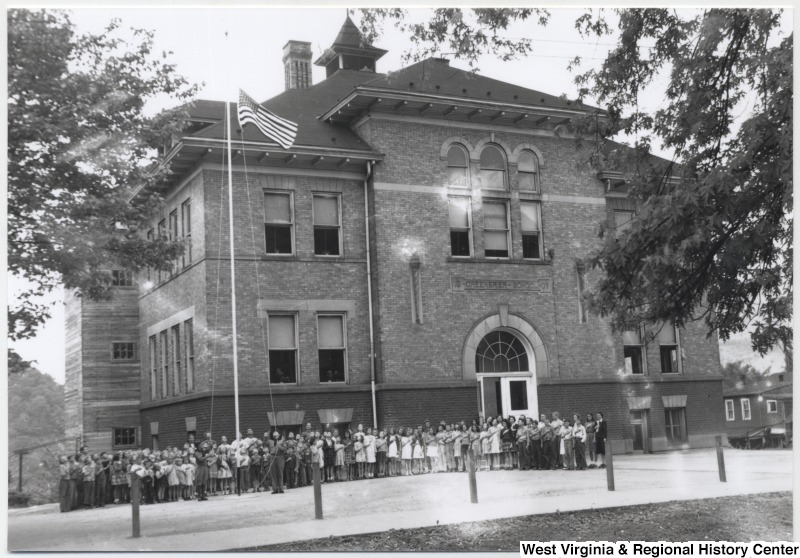
Students pledge allegiance to the flag on Veterans Day at the Greebrier School, Hinton, W. Va., ca. 1950, image from WV History OnView. Read the rest of this entry »
Posted in West Virginia Collection | No Comments »
Posted by Jane Metters LaBarbara.
June 12th, 2018
Blog post by Stewart Plein, Assistant Curator for WV Books & Printed Resources & Rare Book Librarian
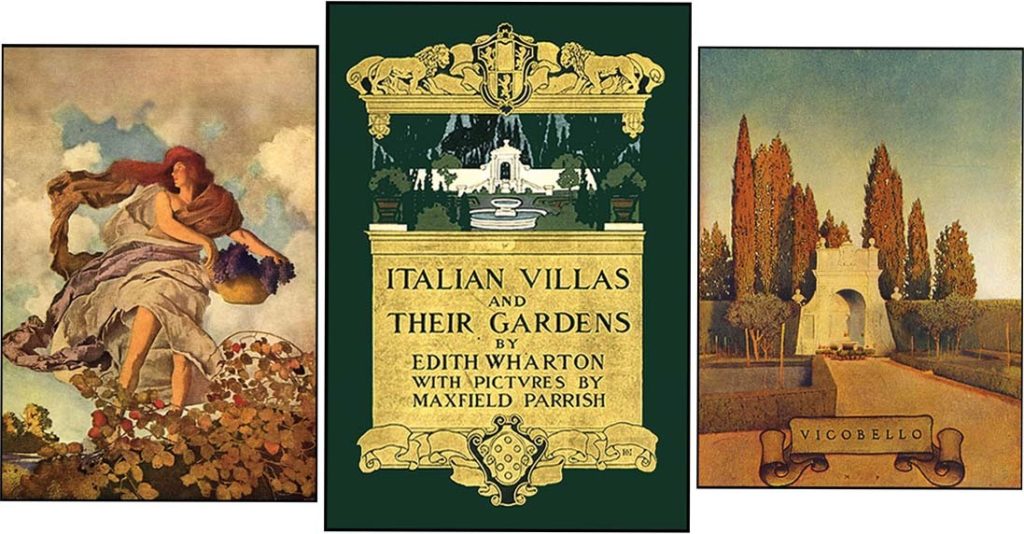
Recently, the WVU Libraries received a large gift from the late Lucinda Ebersole, a collector, book lover, publisher, and bookstore owner, totaling over 11,000 books. Yes, that’s right, over 11,000 books. This extensive collection arrived in near pristine condition, all books in their original dust jackets, and with many rare and antiquarian titles included. Today on the blog, I would like to highlight a book from the collection that I am very excited about, one of those rare and antiquarian titles that I have longed to have in the collection. Read the rest of this entry »
Tags: Rare Books
Posted in West Virginia Collection | 2 Comments »
Posted by Jane Metters LaBarbara.
June 1st, 2018
Blog post by Jane Metters LaBarbara, Assistant Curator, WVRHC.
The way people communicate is evolving along with technology. Today, we have event pages on Facebook to alert friends and customers to upcoming activities, and blog posts and newspaper editorials on the web to share our political feelings. What filled these communication needs before the internet? In some cases, the answer was broadsides! A broadside is “a single sheet with information printed on one side that is intended to be posted, publicly distributed, or sold” (according to the Society of American Archivists). The WVRHC’s broadsides collection includes posters, handbills/flyers, and other types of advertisements and announcements.
Speaking of the internet, not all of the WVRHC’s glorious collections are available on the web. The broadsides collection is not available online, but it is partially cataloged in the card catalog we have at the Center. The broadside catalog cards are arranged in chronological order, from the 1770s-2007; beyond that, we have some yet-to-be-cataloged broadsides for intrepid researchers to explore. Some of our broadsides are originals and some are facsimiles. Below are a few examples to give you an idea of what this collection contains. Read the rest of this entry »
Posted in West Virginia Collection | No Comments »
Posted by Jane Metters LaBarbara.
May 25th, 2018
Blog post by Lori Hostuttler, Assistant Director, WVRHC.
In West Virginia, spring brings a selection of new and fresh foods. Ramps and morels each have a season, as do strawberries and my subject today: rhubarb.
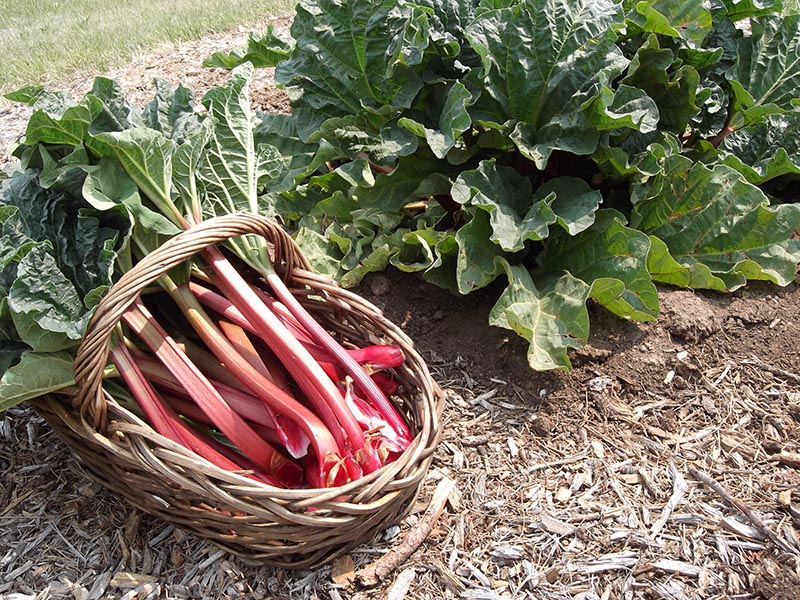
Image from Rhubarb Farmer.
Rhubarb, also called pie plant, is known for its tart flavor. It is considered a vegetable and looks quite a bit like red celery. But most people prepare it as they would a fruit. Because of the tartness, it is often sweetened and used in desserts. Only the stalks can be eaten. The leaves are poisonous and should not be ingested. Read the rest of this entry »
Tags: Recipe
Posted in West Virginia Collection | 2 Comments »
Posted by Jane Metters LaBarbara.
May 21st, 2018
Blog post by Michael Ridderbusch, Associate Curator, WVRHC.
In the course of researching and preparing for this blog series of historical photography of WVU in the 1960s, I sometimes discovered material documenting inaugural moments, such as the opening of Towers 1 and 2, as will be shown here. The construction of the Towers in Evansdale was part of a building initiative in the 1960s that transformed much of the campus, resulting in the Creative Arts Center, the Forestry Building, and the Mountainlair. Read the rest of this entry »
Posted in West Virginia Collection | No Comments »
Posted by Jane Metters LaBarbara.
May 11th, 2018
Blog post by Stewart Plein, Rare Book Librarian
We’re always looking for new books to add to the West Virginia and Regional History Center Reading Room Collection. Recently we added four new books we thought our patrons would enjoy.
Lauren Pond’s Test of Faith: Signs, Serpents, and Salvation, is a photographic documentation of one man’s devotion as displayed through his belief in snake handling. Read the rest of this entry »
Posted in West Virginia Collection | No Comments »
Posted by Jane Metters LaBarbara.
May 1st, 2018
Blog post by Lori Hostuttler, Assistant Director, WVRHC.
The Society of American Archivists has designated May 1 as MayDay, a day to reflect on preparedness in the event of a disaster (big or small) and to take a simple action to ensure the protection of collections. Preservation is an important aspect of the work we do at the West Virginia & Regional History Center and essential to the long term care of the collections in our stewardship. Following some best practices enables us to minimize the risk of damage to materials and help ensure that the history of West Virginia & central Appalachia will be around for researchers for many, many years to come.

Read the rest of this entry »
Posted in West Virginia Collection | No Comments »
Posted by Jane Metters LaBarbara.
April 30th, 2018
Blog post by Jane Metters LaBarbara, Assistant Curator, WVRHC.
Today marks the anniversary of the Everettville Mine Disaster. On April 30, 1927, there was an explosion at the Federal No. 3 mine owned by New England Fuel and Transportation Company, in Everettville, Monongalia County, WV. One hundred and eleven people were lost, and nine were saved. Below are the newspaper headlines for the following week–the disaster happened at around 3:30 PM so it didn’t make the evening edition of the Morgantown Post on April 30–the results of the Great Mississippi Flood took up a lot of front page space that day. The Everettville mine disaster was reported in a number of local newspapers and even made national news. Read the rest of this entry »
Posted in West Virginia Collection | 3 Comments »
Posted by Jane Metters LaBarbara.
April 17th, 2018
Blog post by Michael Ridderbusch, Associate Curator, WVRHC.
This blog will continue to survey photographs from an archival photograph collection received by the History Center from University Relations. It contains photos showing people, activities, and events at West Virginia University from the 1960s to more recent times. This installment of the series will focus on photos that document Wise Library (which is now encompassed within the Downtown Campus Library). Although some of these photographs have probably been seen before, the acquisition of this collection with all of its original negatives will now privilege researchers and viewers with source material of the highest quality.
Read the rest of this entry »
Posted in West Virginia Collection | 1 Comment »
Posted by Jane Metters LaBarbara.
April 9th, 2018
Blog post by Jane Metters LaBarbara, Assistant Curator, WVRHC.
One of the Libraries’ Instagram posts from last month inspired me to research a dog that showed up in a couple of Morgantown fire department photos in our collections.
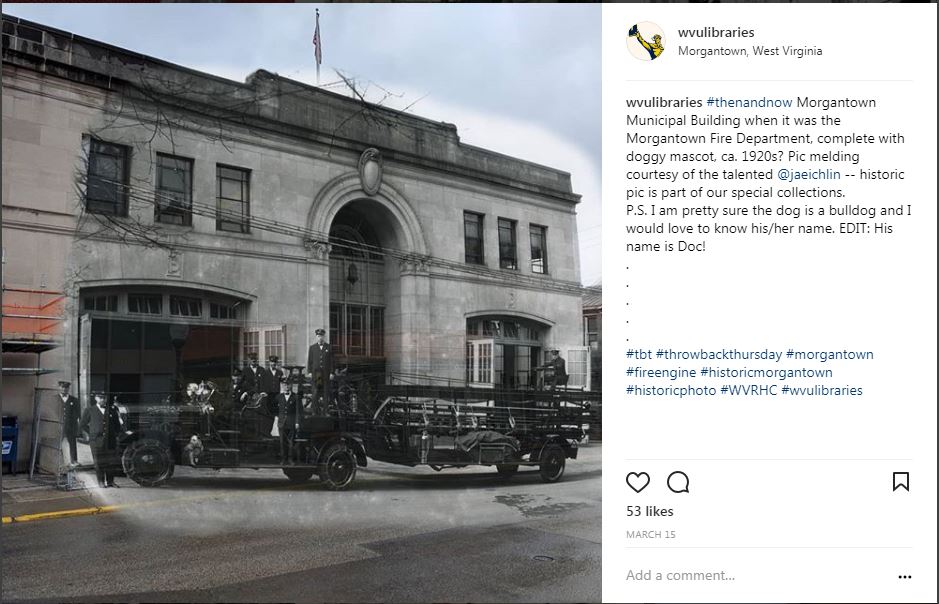
My research took me into the archives at the WVRHC as well as the wonderful historical material kept by the Morgantown Fire Department. They have captain’s logs, scrapbooks, clippings, photos, and other material that tells the story of the MFD; if any of our readers have research interests about the MFD, you can get in touch with our fire chief, Mark Caravasos. He showed me their collection and gave me more information about Doc the fire dog to fill in the gaps in my research. Read the rest of this entry »
Posted in West Virginia Collection | 1 Comment »
Posted by Jane Metters LaBarbara.
April 9th, 2018
Blog post by Stewart Plein, Rare Book Librarian
Last fall, Sally Deskins, Exhibits and Program Coordinator for the Downtown Campus Library, approached me, Stewart Plein, Rare Books curator, and Joe Galbreath, Associate Professor for Graphic Design at the WVU School of Art & Design, with a great idea – to reimagine the design of classic books and their cover art in a new way. Sally was inspired by the Recovering the Classics website, a crowdsourced program that invites “illustrators, typographers, and designers of all stripes to create new covers for 100 of the greatest works in the public domain.”
But Sally had a twist to this great idea – to recover classic Appalachian titles instead of literary classics. Professor Galbreath and I were both excited about the project and began to make plans. Professor Galbreath created an assignment for his Advanced Typography class, Art 328, to visit the WVU Rare Book Room and the West Virginia and Regional History Center’s Reading Room collection to gather inspiration for their reimagined book cover designs. Read the rest of this entry »
Posted in West Virginia Collection | No Comments »















